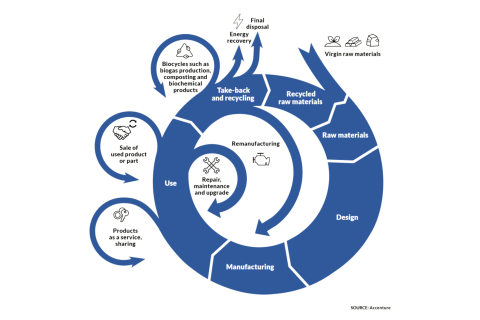Tampere aims to be climate neutral by 2030. We are taking leaps towards climate neutrality in procurement, construction, use of facilities and service production with the help of the whole city. We serve as a platform for sustainable solutions for the future and create partnerships with industries. We support industrial renewal, accelerated by the green transition, and the potential of the circular economy. We boldly take advantage of the opportunities of digitalisation in the service development.
Circular Economy

What is the circular economy?
The circular economy is an economic model where we operate within the carrying capacity of the Earth by keeping products, materials and resources in circulation as long as possible. The circular economy helps to reduce waste, protect natural resources and mitigate climate change and biodiversity loss. Integrating the circular economy into society requires a change in mindset and a focus on the longevity of materials in product design. This means not only recycling, but also designing products from sustainable recycled materials so that they can be repaired, recycled and reused.

Circular economy in Tampere
Tampere City Circular Economy Vision 2030:
Tampere is a pioneer in circular economy expertise both in Finland and Europe. Through bold implementation and determined action, we have adopted the circular economy as a strong part of all the city's activities. With the circular economy, we can ensure a sustainable future for businesses, jobs and well-being together with companies, local residents and other actors.
In 2022, the City Council approved the first circular economy plan in the city's history. According to the plan, Tampere focuses on the following areas in the circular economy: 1) land use planning and plot allocation, 2) circular economy of service networks, real estate and construction, 3) material cycles and waste management, and 4) sustainable food system. One key method for change is various experiments, pilots, and projects, and the systematic application of their lessons.
Ongoing circular economy projects
ReCreate
ReCreate (Reusing prefabricated concrete for a circular economy) is a four-year EU-funded international research project investigating the reuse of concrete elements removed from demolished buildings in new construction. The project is exploring how used precast concrete elements could be removed intact and used as part of new buildings - as a profitable business.
Completed circular economy projects
6aika Sustainable Urban Districts Partnership Model (KIEPPI)
In the KIEPPI project, sustainable urban districts were developed from Espoo’s Kera, Tampere’s Hiedanranta, and Turku’s Science Park, where new circular and sharing economy-based businesses and jobs are created. The main product of the project was a circular economy partnership model, which provides cities and companies with a concrete and easily exploitable tool for cooperation in line with the circular economy. The project also piloted solutions for the circular economy in infrastructure and street construction, urban food production, and sustainable and health-promoting blue-green structures. In Tampere, 24 pilots were carried out with 13 companies. The project was implemented from August 1, 2019 to September 30, 2021.
KIERTO – Growth from Circular Economy
The KIERTO project was a partnership project coordinated by the Employment and Growth Services of the City of Tampere. The project developed the employability of individuals in a disadvantaged labor market position, particularly through learning at the workplace, supported the development of circular economy business of companies and organizations to create new jobs, and increased knowledge, enthusiasm, entrepreneurship, and networking in the circular economy. The project was implemented from December 1, 2021 to August 31, 2023.